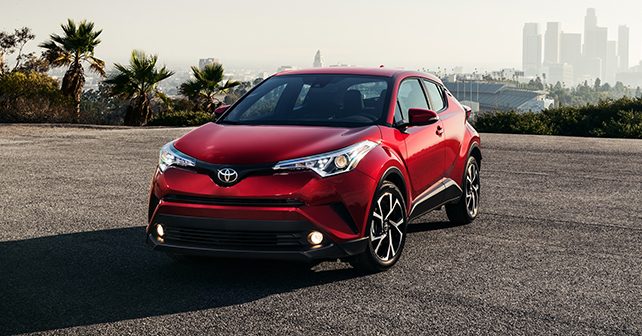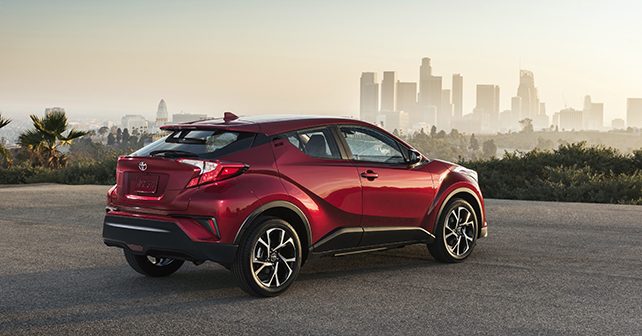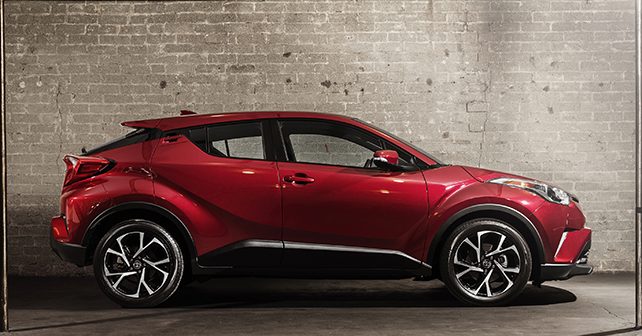Toyota has finally revealed their new compact SUV, the Toyota C-HR at the Los Angeles Motor Show.
Toyota has revealed their all new compact SUV, the Toyota C-HR in America. The Toyota C-HR, or what Toyota likes to call ‘Coupe High Rider’ will go into production early 2017 for the American market.
The design theme given to the creative department for the C-HR was called “Distinctive Diamond” and achieve four main characteristics on the exterior of the car – luxury, attractiveness, sophistication, and strength. The front of the car has two slim projector-beam halogen headlamps with LED DRLs that run from the front grille, all the way to the side quarter panels into the bold shoulder line fading out above the rear wheel arch. The rear door handle is also integrated into the C-pillar in a very clever way. It has large 18-inch aluminium wheels a compact cabin between the wheelbase.
The ‘diamond’ theme continues into the cabin of the C-HR, with chiselled edged styling and a ‘driver centric MeZONE’ orientation. Toyota has used soft touch materials around the cabin for a premium feel, and loaded the vehicle with gadgets as standard like dual-zone auto climate control, bucket seats, 7-inch infotainment system screen that supports Bluetooth, USB port, AUX and voice recognition and command.
The centre console is angled towards the driver, a twin gauge instrument cluster with a 4.2-inch colour Multi-Information Display between the two dials behind the leather-wrapped multi-function steering wheel. The C-HR also features Blind Spot Monitor and Rear Cross Traffic Alert; heated front seats; and Smart Key with Push Button Start and more.
The C-HR will be powered by a 2.0-litre four cylinder Variant Valve Timing (VVT) and Valvematic engine that produced 144bhp which powers the front wheels through a Continuously Variable Transmission (CVT). The CVT gearbox also features a Sport mode that simulates a 7-speed Sequential Shiftmatic gearbox giving the driver a more sporty feel to the drive, in addition to livening up the throttle response.
To develop the C-HR, Toyota weirdly took the car to the Nurburgring to hone the suspension set-up of the car and tune the engine for a sporty drive. The deputy chief engineer of the car, Hiro Koba with his team developed the C-HR on the iconic German racetrack. Developing the C-HR at the Nurburgring helped Toyota tune the engine to be lively and sporty, while the suspension has also been tuned for a comfortable ride on the road, and to stiffen up well, when required. The C-HR uses the Toyota New Global Architecture (TNGA) and developing at the Nordschleife, allowed the designers to lower the centre of gravity of the car, give it high strength and a low overall weight with an extra rigid structure.
The C-HR uses a MacPherson strut front setup with SACHS dampers and angled bearings and a large diameter anti-roll bar to help the car corner better it high speeds. The rear gets a double wishbone setup with SACHS shock absorbers with urethane upper supports. the C-HR uses a column-type Electric Power Steering system with a rack and pinion mechanism bolted directly to he front suspension and is tuned to provide better feedback at higher speeds.
The Toyota C-HR is for the moment focused on the American market and competes with the likes of the Hyundai Tucson, Honda CR-V and Volkswagen Tiguan. Will Toyota ever bring the C-HR to the Indian market is unlikely, but it would be a shame if they didn’t.
Also Read: New Toyota Fortuner Review: First Drive






















Write your Comment